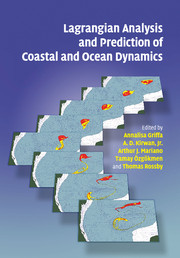Book contents
- Frontmatter
- Contents
- List of contributors
- Preface
- 1 Evolution of Lagrangian methods in oceanography
- 2 Measuring surface currents with Surface Velocity Program drifters: the instrument, its data, and some recent results
- 3 Favorite trajectories
- 4 Particle motion in a sea of eddies
- 5 Inertial particle dynamics on the rotating Earth
- 6 Predictability of Lagrangian motion in the upper ocean
- 7 Lagrangian data assimilation in ocean general circulation models
- 8 Dynamic consistency and Lagrangian data in oceanography: mapping, assimilation, and optimization schemes
- 9 Observing turbulence regimes and Lagrangian dispersal properties in the oceans
- 10 Lagrangian biophysical dynamics
- 11 Plankton: Lagrangian inhabitants of the sea
- 12 A Lagrangian stochastic model for the dynamics of a stage structured population. Application to a copepod population
- 13 Lagrangian analysis and prediction of coastal and ocean dynamics (LAPCOD)
- Index
- Plate section
- References
7 - Lagrangian data assimilation in ocean general circulation models
Published online by Cambridge University Press: 07 September 2009
- Frontmatter
- Contents
- List of contributors
- Preface
- 1 Evolution of Lagrangian methods in oceanography
- 2 Measuring surface currents with Surface Velocity Program drifters: the instrument, its data, and some recent results
- 3 Favorite trajectories
- 4 Particle motion in a sea of eddies
- 5 Inertial particle dynamics on the rotating Earth
- 6 Predictability of Lagrangian motion in the upper ocean
- 7 Lagrangian data assimilation in ocean general circulation models
- 8 Dynamic consistency and Lagrangian data in oceanography: mapping, assimilation, and optimization schemes
- 9 Observing turbulence regimes and Lagrangian dispersal properties in the oceans
- 10 Lagrangian biophysical dynamics
- 11 Plankton: Lagrangian inhabitants of the sea
- 12 A Lagrangian stochastic model for the dynamics of a stage structured population. Application to a copepod population
- 13 Lagrangian analysis and prediction of coastal and ocean dynamics (LAPCOD)
- Index
- Plate section
- References
Summary
Introduction
In the last 20 years, the deployment of surface and subsurface buoys has increased significantly, and the scientific community is now focusing on the development of new techniques to maximize the use of these data. As shown by Davis (1983, 1991), oceanic observations of quasi-Lagrangian floats provide a useful and direct description of lateral advection and eddy dispersal. Data from surface drifters and subsurface floats have been intensively used to describe the main statistics of the general circulation in most of the world ocean, in terms of mean flow structure, second-order statistics and transport properties (e.g. Owens, 1991; Richardson, 1993; Fratantoni, 2001; Zhang et al., 2001; Bauer et al., 2002; Niiler et al., 2003; Reverdin et al., 2003). Translation, swirl speed and evolution of surface temperature in warm-core rings, which are ubiquitous in the oceans, have also been studied with floats by releasing them inside of the eddies (Hansen and Maul, 1991). Trajectories of freely drifting buoys allow estimation of horizontal divergence and vertical velocity in the mixed layer (Poulain, 1993). Also, data from drifters allows investigation of properties and statistics of near-inertial waves, which provide much of the shear responsible for mixing in the upper thermocline and entrainment at the base of the mixed layer (Poulain et al., 1992). Drifters have proved to be robust autonomous platforms with which to observe ocean circulation and return data from a variety of sensors.
- Type
- Chapter
- Information
- Lagrangian Analysis and Prediction of Coastal and Ocean Dynamics , pp. 172 - 203Publisher: Cambridge University PressPrint publication year: 2007



